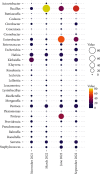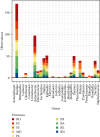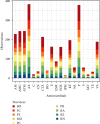Antimicrobial-Resistant Environmental Bacteria Isolated Using a Network of Honey Bee Colonies (Apis mellifera L. 1758)
- PMID: 40303743
- PMCID: PMC12016942
- DOI: 10.1155/2023/5540574
Antimicrobial-Resistant Environmental Bacteria Isolated Using a Network of Honey Bee Colonies (Apis mellifera L. 1758)
Abstract
The phenomenon of antibiotic resistance stands as a paramount health challenge in the contemporary era. Within a One Health approach, it becomes crucial to effectively track the dissemination of antibiotic resistance, not only within humans and animals but also within the environment. To investigate the environment, the honey bee (Apis mellifera) has emerged as a prominent environmental bioindicator due to its social, behavioral, and morphological features. The objective of this study was to describe the antimicrobial resistance (AMR) patterns of bacterial isolates from the body surface and the gut of honey bees sampled from 33 colonies throughout the Emilia-Romagna region (Italy). A total of 608 strains were examined for 19 distinct antimicrobial compounds from various classes, and the results showed that more than 50% of the isolates for eight out of nine provinces showed characteristics of nonsusceptibility toward amoxicillin and penicillin, and, generally, 98.19% of isolated strains were considered AMR and 74.67% exhibited multidrug resistance (MDR) characteristics, more frequent in Gram-negative strains (87.74%) than in Gram-positive ones (60.34%). Additionally, a significant correlation with a lower prevalence of MDR bacteria was demonstrated for one province (Ferrara, odds ratio (OR) = 3.33, (1.67; 6.64), p=0.0006). In conclusion, this study provides evidence for the utility of A. mellifera colonies as bioindicators for MDR bacteria, enabling their characterization and distribution at a geographical level. Additional investigations are required to further explore the potential role of honey bees as bioindicators for antimicrobial-resistant bacteria, particularly in terms of their association with environmental characteristics.
Copyright © 2023 Giovanni Cilia et al.
Conflict of interest statement
The authors declare that there are no conflicts of interest regarding the publication of this paper.
Figures




References
-
- World Health Organization. Global Antimicrobial Resistance and Use Surveillance System (GLASS) 2021. Report 2021 ISBN 9789240005587.
MeSH terms
Substances
LinkOut - more resources
Full Text Sources
Medical

